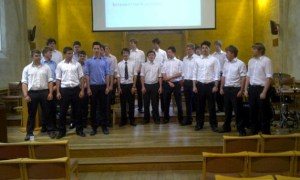Today we welcome George Bevan, Director of Music at Monkton Combe School, to share his experiences teaching the ‘tone deaf’ and encouraging singing through solfège… to build the “Choir Who Can’t Sing”.
I have done a lot of research lately on apparent tone deafness, and have come to the conclusion that most teenage boys who think that they are tone deaf are not!
It is less of an input problem and more of an output problem – not so much a lack of ability to hear, so much as an inability to identify how physically to reproduce the sounds which they hear. I suspect that true tone deafness is impossible to fix, but the latter condition is most definitely not.
Neglected Ears
For as long as I have been teaching I have encountered far too many instrumental teachers who sadly do not see aural training, or even musicianship training, as their responsibility. Over the years I have often had a child sent my way, with perhaps just a few days to go before an instrumental exam, to “run through a few aural tests.”
“Most teenage boys who think that they are tone deaf are not!”
I remember being amazed, perhaps 15 years ago now, when one such child, a Grade 3 euphonium player, showed up in my room. He just couldn’t sing anything like in tune – nowhere close! I wondered how his lessons to date had possibly been classified as music lessons.
There was simply no time to begin to help him, and I sent him away with a “just do your best” – in the circumstances there was nothing I could do. I felt like we had failed him.
I have seen many like him since, but it was not until arriving in my current school, Monkton Combe, that I finally found the space to start doing something about this on a more significant scale than just a little last minute one-to-one quick fix.

The Choir Who Can’t Sing
Over the past two years I have done a great deal of work with teenage boys who just don’t seem to be able to sing at all, resulting in a project called “The Choir Who Can’t Sing” which has now been running for about 18 months.
Many teenage boys have quite a narrow pitch range in their speaking voice, and they generally loiter in the lower register of their voice! One of the problems with singing is that they are expected to use a part of their voice which for many of them gets very little use, except perhaps on the games field. As soon as they are expected to sing high they just fall back to their default ‘growl’.
“It’s about careful listening with the inner ear first. In my experience, this alone makes all the difference.”
I start by asking them to sing something right at the bottom of their vocal range – what I call their ‘lazy’ voice. I sing the note to them, and ask them to copy. Don’t use the piano, since this gives no clue as to how and where the sound is actually produced by the human body. Before singing back, I ask them to imagine physically singing the note, to go through the whole process with their body and in their inner ear so that they know exactly what they are going to be aiming at. Many inexperienced singers just sing a random note, quite possibly because they just don’t know where the target is! Set the tone – it’s about careful listening with the inner ear first. In my experience, this alone makes all the difference.
Initially I saw about 20 boys, and was able to tell each one within two minutes that they were not tone deaf, just in need of a little extra help to get them going. All of them sang back the very same notes which I sung to them, first time. This was enough to persuade them to come back for more!
Build up slowly, build up confidence
Having switched on their ears and adopted a careful listening approach, they can tell once they are singing the same note as me. Physics also helps – the natural beats which are set up when two notes are not quite in tune (most easily identifiable when two flautists play in ‘unison’!) disappear once perfect tuning occurs. Standing face to face, it’s difficult to miss this.
Having found their note – “you’re an A flat man!” – we move on and explore the next two or three notes in the scale (using solfa). Before singing each note I encourage them to take their time, go through the complete process in their inner ear first, and when they are ready: sing. It works!
The “Choir Who Can’t Sing” – Singing Take That’s “Shine”
There is perhaps not room to write more extensively here, but there are two more things required: good breath support and confidence.
The latter is vital, and the secret ingredient here is that these lads know that I believe in them. If they are struggling I tell them not to worry, it’s just that I haven’t worked out how to fix them perfectly just yet – but I will. And of course the the “Choir Who Can’t Sing’ can sing; but it’s a choir with a difference, where students who can’t sing are actively welcomed into an environment where others have been in their situation not too long ago.
The Power of One
One more helpful hint, which I learned from the inspirational Cyrilla Rowsell. Three years ago I found myself attending a British Kodàly Academy Spring Course, and on one afternoon we were all sat in a circle singing children’s songs with Cyrilla.
When collectively we hadn’t quite mastered a song she would single out one person to sing back a line, and then another person, and then we would all sing together again – and this time it would be perfect.
When one person sings, people listen more carefully and attentively.
A simple lesson indeed, but I use this with the ‘Choir Who Can’t Sing’ at the start of each rehearsal when we do our ‘calibration’ exercise: we sing a few ‘lazy’ voice notes, and if one or two are out of tune I select one or two others to sing the note by themselves (it’s always surprising how many volunteer themselves!). Then, having set the tone for careful listening, the out-of-tune ones have another go. And then we all sing together again.
There is little else that has satisfied me more in twenty years or more of teaching than hearing more than 30 ‘tone deaf’ boys all singing the very same note… and for all its simplicity, loving it!










Good one- sounds v encouraging! If my singing teacher 50 years ago knew that maybe i wouldn't be so hopeless now. As usual I just wish every music teacher everywhere knew about the EET site……
Keep up the good work.
Thanks, Jean! We found George's tale really encouraging too.
There's so much potential that's gone to waste over the years from young students getting unnecessarily discouraged in music. It's inspiring to hear of a choirmaster turning that on its head!
Love this, really inspiring. Whilst ideally ear-training should start with language learning in the early years, this shows that it is still possible to really make a difference later on. Love the faces of the boys when they are singing, they are obviously really enjoying it. Well done George, amazing!